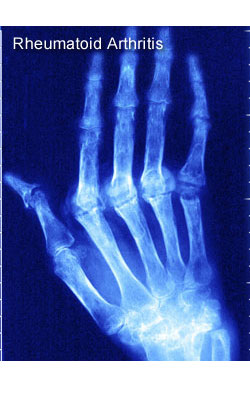
Rheumatoid arthritis is a chronic inflammatory disease which mainly affects the small joints (namely the joints of the fingers, feet, back of the neck etc) of the body with involvement of other organs of the body in some. In the US alone about 0.6% of the total population suffer from rheumatoid arthritis.
Common presenting symptoms of rheumatoid arthritis are painful, swollen and stiff joints of the body; usually the small joints are affected although in many cases large joints of the body like the knee or shoulder joint. Repeated episodes of fracture may also occur following minimal trauma due to bone loss (osteoporosis). Characteristic bony deformities are another type of presenting symptom in patients suffering from late stage of rheumatoid arthritis. Symptoms may also occur following involvement of other organs like difficulty in breathing due to lung involvement, increased incidence of atherosclerosis, heart attack, stroke, nerve involvement like carpal tunnel syndrome, polyneuropathy leading to tingling, numbness of the affected area, anemia etc.
Unlike osteoarthritis which is a wear and tear type of joint disease rheumatoid arthritis is an autoimmune disease in which the immune system wrongly attacks the “self” cells instead of the foreign invading agents.
There is no cure for rheumatoid arthritis however with treatment disease progression and the resulting complications can be arrested to some extent.
Causes
Rheumatoid arthritis is an autoimmune disease, in which the immune system produces antibodies against own body cells instead of against foreign cells. The factors which trigger this type of immune response are not clearly known but certain genetic factors like HLA DR4, are associated with causation of the disease. These genetic factors may not lead to rheumatoid arthritis but these factors tend to increase the person’s susceptibility to certain infections (bacterial and viral, like Epstein Barr virus, human herpes virus 6) which are known to trigger rheumatoid arthritis. Some studies have shown that vitamin D deficiency may be associated with rheumatoid arthritis.
The immune system usually attacks the synovial membrane lining the joint cavities leading to the main symptoms of rheumatoid arthritis, although other organs may also be affected leading several other symptoms. Inflammation of the synovial membrane leads to thickening of the membrane, destruction of the cartilage and the adjoining bones. With time the adjacent tendons and ligaments holding the joints become weak and lax leading to alteration of shape and alignment of the bones in the joints resulting into characteristic bony deformities.
Other symptoms arise following inflammatory changes in the respective organs.
Risk factors
Common associated risk factors include
1. Being a middle aged women usually between 30 and 60 years of age
2. Family history of rheumatoid arthritis
Treatment
There is no cure available for rheumatoid arthritis. However drugs are available which slow the disease progression and prevents occurrence of complications to some extent.
Commonly used drugs include
1. NSAIDs: these drugs are recommended to relieve pain and inflammation. Commonly prescribed NSAIDs are ibuprofen, naproxen etc.
2. Corticosteroids: these drugs like prednisolone are also recommended to reduce inflammation and the resulting joint damages.
3. Disease modifying antirheumatic drugs (DMARDs): these drugs slow the progression of the disease. Commonly prescribed drugs in this group are methotrexate, leflunomide, sulfasalazine etc.
4. Immunosuppressants: these are used to suppress the abnormal immune response. Commonly prescribed drugs of this group are azathioprine, cyclosporine etc
5. TNF alpha inhibitors like adalimumab, infliximab etc are used reduce the inflammatory symproms like pain, swelling and stiffness of the joints.
Other drugs; different drugs with different target sites namely anakinra, rituximab, abatacept etc are prescribed.
6. Other than drugs physical therapy, occupational therapy etc are also required.
Surgery is required when drugs fail to halt the progression of the disease and the resulting joint deformities. Commonly performed surgical procedures are total joint replacement, repair of lax tendons, surgical fusion of joints to stabilize and realign the joints etc.





